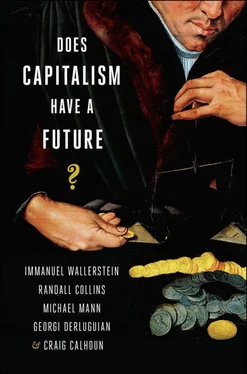Though capitalism seems unlikely to collapse next week, it is also unlikely to last forever. It remains unwise to imagine the future only in terms of linear projections from the present.
Capitalism could be felled by internal contradictions, including its general propensity to crises and the specific intensification of risk that has accompanied lopsided financialization in much of the world. Indeed, surprisingly little has been done after the 2008–2009 market meltdown to improve regulation or market structures; the same firms and people remain largely in charge. The same risks are therefore still with us.
Equally important, though, are potentials for external disruption, whether from environmental catastrophes, diseases, wars, or rebellions. Infrastructural systems on which capitalism depends, like communications networks or energy supplies, could also be disrupted, possibly by political actors. For all these reasons, what has been a process of ever-tighter global integration may be partially reversed. Coping with disruptions may depend on more loosely coupled systems with different bases for resilience.
Capitalism could decline without collapsing, simply organizing less of economic activity as alternative systems organize more. Growth could slow. This could happen globally or, more likely, unevenly by country and region. The ever-tighter integration of global markets that capitalism has driven might be slowed or reversed, with differently organized systems in different settings. Capitalism might be more central to some of these, more hemmed in or marginal in others. Business firms, operating in close relationship to governments, could manage economic relations more, leaving less to “free” markets. They could be organized with more attention to goals other than capital accumulation. Social and political institutions might provide stronger or weaker counterbalances to capitalism; illicit capitalism could loom larger or smaller. Capitalism could thus remain a vital part of global political economy, but be less dominant. Or a radically new economic structure could develop.
The current crisis is not the first time that capitalism has survived only because states were willing to intervene and assume enormous costs created by capitalist “excesses.” Of course, the citizens to whom these externalized costs are distributed are often unhappy. But if states aid capitalism by absorbing costs firms externalize, they also aid citizens by managing risks from unemployment to illness. So far there is little sign of social movements potentially able to topple states that impose austerity in order to defend capitalist financial institutions. This does remind us, though, that at least as important as capitalist vulnerability to crises is the likelihood that capitalism will be undermined by destruction of the political, social and environmental conditions on which it depends.
Meeting institutional deficits is a basic challenge. Of course the challenge can be met by nonstate institutions as well as states, particularly by nonprofit organizations but also sometimes by capitalist firms where they are stable enough to work as social institutions supporting their employees. Contemporary global capitalism is also buffered for many people by an informal sector that sustains populations poorly served by existing institutions but that also extends into large-scale corruption. A massive illicit sector mingles tax evasion with criminal enterprises. Both informal and illicit sectors are interdependent with more formal and legitimate capitalism. Yet they undermine institutions on which it depends, including states.
Whether states are able to continue providing operating conditions for capitalist growth is a serious question, as much in parts of Europe as in less developed countries more commonly associated with the phrase “fragile states.” Fiscal crises complement security challenges. Infrastructural and other growth-oriented investments have been hard to deliver effectively. Regulating global finance and meeting environmental challenges call for effective large-scale, transnational governance structures, but efforts to create these are relatively weak. Holding together a global world-system depends on the hegemony and disproportionate contributions of some members. The United States’ willingness to carry these burdens unilaterally is declining but neither a replacement nor a multilateral alternative has emerged. One possibility is that the world-system will lose cohesion in favor of competing regional structures—and capitalism may matter more in some than others.
Capitalism itself contributes to some of the “external” disruptions that may challenge its future growth—notably environmental degradation and climate change. There may be possibilities for “green growth” that will sustain capitalism and deal with the environmental challenge. Or there may be limits to growth that make capitalism itself problematic and unsustainable, simply because it is in the end a growth machine.
With regard to each sort of threat, there are actions to be taken that could counterbalance the damage and mitigate the risks of one-sided capitalist development. These could come from for-profit and nonprofit entrepreneurs as well as governments. They could be pursued by social movements—though so far none have risen to the scale of the global challenges. In any case, capitalism cannot thrive if institutions are not reshaped, employment restored, and environmental, public health, and other challenges addressed.
The large-scale, more or less simultaneous collapse of capitalist markets would be catastrophic, not only bringing economic upheaval but also upending political and social institutions. It could be precipitated by systemic crises or more likely brought about by ecological change or violence. The risk is heightened by capitalist externalization of costs and damage both to the environment and to potentially stabilizing social institutions. But discontinuous changes are not always sudden or catastrophic.
As I began by suggesting, it is at least as likely that capitalism will be transformed over generations, possibly beyond recognition. Arguably stronger states, better agricultural productivity, and renewal of religious faith were all solutions to problems in feudal Europe. They also transformed it and in the long run brought a new era. The rise of both state risk management and economic facilitation and capitalist corporations offered solutions to problems in mid-20th century capitalism. These were transformative, though contained in a still-capitalist order.
That capitalist order is a very large-scale, highly complex system. The events of the last forty years have deeply disrupted the institutions that kept capitalism relatively well organized through the postwar period. Efforts to repair or replace these will change the system, just as new technologies and new business or financial practices may. Even a successful renewal of capitalism will transform it and the modern world-system within which it has driven growth for 400 years. If nothing else, capitalism will be transformed by the extent to which growth is led from outside its long-standing Western core regions and this will integrate it with different histories, cultures, and social institutions.
The question is whether change will be adequate to manage systemic risks and fend off external threats. And if not, will there be widespread devastation before a new order emerges?

GETTING REAL
The Concluding Collective Chapter
Immanuel Wallerstein, Randall Collins, Michael Mann, Georgi Derluguian, and Craig Calhoun
Читать дальше













